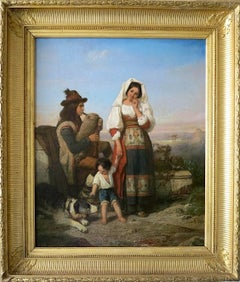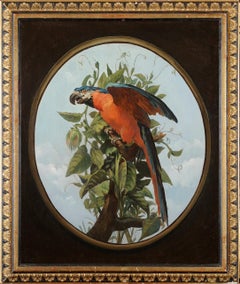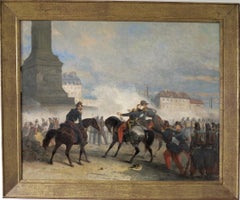Want more images or videos?
Request additional images or videos from the seller
1 of 10
Mignon regretting his homeland - Mignon aspiring to heaven
$5,828.74List Price
About the Item
- Dimensions:Height: 17.33 in (44 cm)Width: 18.12 in (46 cm)
- Medium:
- Movement & Style:
- Circle Of:Ary SCHEFFER (1795 - 1868, French)
- Period:
- Condition:
- Gallery Location:Paris, FR
- Reference Number:Seller: T528 02 211stDibs: LU1954210222672
About the Seller
No Reviews Yet
Vetted Professional Seller
Every seller passes strict standards for authenticity and reliability
Established in 2014
1stDibs seller since 2022
13 sales on 1stDibs
Authenticity Guarantee
In the unlikely event there’s an issue with an item’s authenticity, contact us within 1 year for a full refund. DetailsMoney-Back Guarantee
If your item is not as described, is damaged in transit, or does not arrive, contact us within 7 days for a full refund. Details24-Hour Cancellation
You have a 24-hour grace period in which to reconsider your purchase, with no questions asked.Vetted Professional Sellers
Our world-class sellers must adhere to strict standards for service and quality, maintaining the integrity of our listings.Price-Match Guarantee
If you find that a seller listed the same item for a lower price elsewhere, we’ll match it.Trusted Global Delivery
Our best-in-class carrier network provides specialized shipping options worldwide, including custom delivery.You May Also Like
Alexander the Great in the Darius house
Located in BELEYMAS, FR
French School, Late 18th Century
Alexander the Great in the House of Darius
Oil on canvas
H. 42 cm; W. 53.5 cm without frame
Apocryphal signature lower right "Verhag..."
This painti...
Category
1780s French School Portrait Paintings
Materials
Canvas, Oil
Academic Study
Located in London, GB
Oil on canvas
Signed, dated and dedicated (upper right)
46cm × 38cm (59cm × 51cm framed)
Forichon was a pupil of the Ecole des Beaux-Arts de Paris and was taught by Jean-Léon Gérôme...
Category
1880s French School Figurative Paintings
Materials
Canvas, Oil
Red-haired beauty portrait oil painting on canvas by René Avigdor 19Th Century
Located in Gavere, BE
Red-haired beauty portrait oil painting on canvas by René Avigdor 19Th Century
Rene Avigdor was born in Nice and spent his career in France.
He specialized in portraits, especiall...
Category
1890s French School Portrait Paintings
Materials
Gold Leaf
$11,096 Sale Price
20% Off
Free Shipping
H 31.89 in W 29.53 in D 4.73 in
18th Century French School Portrait of an Actress with Flowers
Located in Beachwood, OH
18th Century French School
Portrait of an Actress
Oil on canvas
30 x 23 inches
36 x 30 inches, framed
Category
18th Century French School Figurative Paintings
Materials
Oil
The Beautiful Maiden
By Jan Van Beers
Located in St. Albans, GB
Jean Marie Constantin Joseph (Jan) VAN BEERS
Oil on Panel
Panel Size: 32 x 24" (81 x 62cm)
Outside frame Size: 38 x 33" (97 x 83cm)
Van Beers (1852 ...
Category
1870s French School Figurative Paintings
Materials
Oil
Antique portrait oil painting of an art lesson by Swiss artist Louis Patru
Located in AIGNAN, FR
Antique portrait painting of two woman having an art lesson by Swiss artist, Louis Patru (1871-1905). This is an unusual painting from an artist who only enjoyed a short life. Two ...
Category
1890s French School Portrait Paintings
Materials
Oil
Declaration of Adultery with Bailiff Oil on Canvas
Located in Pasadena, CA
Oil on canvas probably representing a finding of adultery at the end of the 19th century. The scene is painted with many details in a camaieux of gray colors . The edges of the paint...
Category
Late 19th Century French School Figurative Paintings
Materials
Oil
"Maria" Portrait of a Girl New Hope Pennsylvania Artist Edna Gass
By Edna Gass
Located in Soquel, CA
"Maria" Portrait of a Girl New Hope Pennsylvania Artist Edna Gass
"Enfant" portrait of a child by New Hope Artist Edna Gass (American, 1904–1993).
This portrait is one of rare Monoty...
Category
1930s French School Figurative Paintings
Materials
Oil, Illustration Board, Monotype
$1,850
H 10 in W 8 in D 1 in
The Dasiy Crown - Belle Epoque Oil Painting Portrait of French Flower Girl
Located in Gerrards Cross, GB
‘La Couronne de Marguerite’ by Édouard-Louis-Lucien Cabane (1857-1942).
Academy Fine Paintings is fully conversant with the latest US Government import duties and the legal exempti...
Category
1910s French School Portrait Paintings
Materials
Oil
$5,393 Sale Price
20% Off
H 23 in W 20 in D 3 in
Fine Antique French Signed Oil Painting Portrait Young Lady in Turban
Located in Cirencester, Gloucestershire
Portrait of a Young Lady wearing pink and a Turban headpiece
by Henri-Charles Daudin (1864-1917, French)
signed oil on wood panel, unframed
board: 14 x 10.5 inches
provenance: privat...
Category
Late 19th Century French School Portrait Paintings
Materials
Oil
$1,743 Sale Price
20% Off
H 14 in W 10.5 in
More From This Seller
View AllSouvenir from Italy: Pifferaro playing the zampogna with the family
Located in Paris, IDF
Joseph BEAUME
(Marseille, 1796 – Paris, 1885)
Souvenir from Italy: pifferaro playing the zampogna with the family
Oil on canvas
Signed lower left
73.5 x 60 cm
Provenance: probably...
Category
Mid-19th Century French School Figurative Paintings
Materials
Oil
Blue macaw perched on a branch
By Jean-Baptiste Oudry
Located in Paris, IDF
French school of the second half of the 19th century,
follower of Oudry
Blue macaw perched on a branch
Oil on canvas
73 x 60 cm
Category
Late 19th Century French School Portrait Paintings
Materials
Oil
Full-length portrait of Jules Michel Simonet (1834-1881) as a child with his dog
Located in Paris, IDF
Benjamin Théophile CHARON-LÉMERILLON
(Paris, 1807 – Bouzareah (Algiers), 1873)
Full-length portrait of Jules Michel Simonet (1834-1881) as a child with his dog
Oil on canvas
Signed...
Category
Mid-19th Century French School Portrait Paintings
Materials
Oil
The death of General Négrier on Place de la Bastille, Paris - France
By Nicolas Edward Gabé
Located in Paris, IDF
Nicolas Edward GABE
(Paris, 1814 - Paris, 1865)
The death of General Négrier on Place de la Bastille on June 25, 1848
Oil on canvas
Signed and dated lower right
82 x 101 cm
1849
Nicolas Edward Gabé is a 19th century artist who is still little studied to this day and yet seems to have enjoyed, according to the artistic press of the time, a certain notoriety, in particular for his seascapes.
The few bibliographical elements that we have come from the Salon booklets and tell us that the artist was born in Paris in 1814, therefore shortly before the end of the Empire.
No elements on his artistic training are mentioned in the booklets, we just know that Gabé exhibited at the Paris Salon from 1835 to 1864 where he first practiced miniature then then approached easel painting, risking himself as well in still life that the seascapes, the landscape, the portrait or the hunting.
According to press articles, he also took part in various exhibitions in the provinces such as Boulogne-sur-Mer and Marseille.
Notably, Gabé did not exhibit at the Salon his large historical canvases on the revolution of 1848, which today are of obvious documentary and iconographic interest; probably for political reasons which are easily understandable to us today in view of the historical events of then.
Gabé died in Paris at the age of 51 on January 4, 1865 with a mention in the January 7, 1865 edition of L'Union des Arts: “The death of Mr. Gabé, painter, well known in the export trade in paintings as well as to the auctioneers' hotel, whose sales it supplied through its numerous navies. “
"On June 25, 1848, in front of the barricades erected in the Bastille by the insurgents of the Red Republic, General Négrier fell to death, while he was uttering words of order and conciliation". Here are the opening lines of the tribute paid by Colonel Borgarelli d´Ison, friend of General Négrier.
General Négrier belonged to a family from Maine, brought back by Marshal Lannes from emigration. Born in Le Mans on April 27, 1788, François Marie Casimir de Négrier entered, barely 18, as a volunteer in the 2nd Light Infantry Regiment. He began in 1806 with the campaigns of Prussia and Poland, during which he earned, through his bravery, the rank of sergeant and the decoration of the Legion of Honor. He made the following campaigns in Spain and Portugal, and left, with his regiment, only for the campaign of France, in 1814, after having risen successively, by actions of brilliance and by a serious wound, to the ranks of head of battalion and officer of the Legion of Honor, with which he was provided from October 1813. The Restoration retained his rank in his regiment. After having fought and wounded a second time seriously in Waterloo, Négrier was recalled in 1816 under the second Restoration. He was appointed, in 1825, lieutenant-colonel, then colonel in 1830, brigadier general in 1836, and of division in 1841. From March 1837 he participated in the conquest of Algeria.
The Revolution of 1848 found Negrier in possession of the important command of the 16th Military Division in Lille. Quaestor of the Assembly in these times which promised to be troubled, Négrier reviewed the Place de la Concorde on June 23 at around noon various mobile guard battalions. He then took the head of 2,000 men provided by the 10th and 11th legions of the national guard and bivouacked on the Place du Palais until the next day 24. On Sunday 25 at nine o'clock, the Négrier division resumed the fight towards the Saint suburb. -Antoine. The troop gains continual advantages. At around two o'clock the column of Négrier had seized the Pont Marie: it had removed the barricades from the Quai Saint-Paul, the rue de l'Etoile, the rue des Barres...
Category
Mid-19th Century French School Figurative Paintings
Materials
Oil
Portrait of a worldly woman
Located in Paris, IDF
Marie Madeleine Amélie LOISEAU, born DUMONT
(Paris, 1860 - ?)
Portrait of a worldly woman
Oil on canvas
Signed and dated lower left
117 x 89 cm
1881
Exhibition: Salon de Pontoise of 1881 or 1882 under number 292
Marie Madeleine Amélie Dumont was born in Paris on January 23, 1860. She married on June 10, 1883 in Paris Mr. François Paul Raoul Loiseau, lawyer at the Paris Court of Appeal. Three children were born from this union, two girls and a boy.
Marie Loiseau was a student of Mademoiselle Espérance Langlois (active between 1860 and 1890) and Pierre Dupuis...
Category
Late 19th Century French School Portrait Paintings
Materials
Oil
Study for "The coronation of Tasso"
Located in Paris, IDF
Alexandre Toussaint MENJAUD
(Paris, 1768 – Paris, 1832)
Study for The coronation of Tasso
Oil on paper mounted on canvas
37.5 x 29.5 cm
Around 1819
Related work: Painting exhibite...
Category
Early 19th Century French School Figurative Paintings
Materials
Oil
Recently Viewed
View AllMore Ways To Browse
Girl With Blue Eyes Oil Painting
Rene His
Miami Beach Vintage
Mother And Child Paintings
Sleep Painting
Oil Paintings Of Jewish Man
Portrait Of President
Skull Paintings
Twin Brothers
Israeli Oil Painting
Old Master Oil On Wood Panel
Naive Folk Art
Painting Of Children
Jewish Paintings
Antique Tempera Painting
Artist Raymond
Jesus Painting
Naive Art Painting



